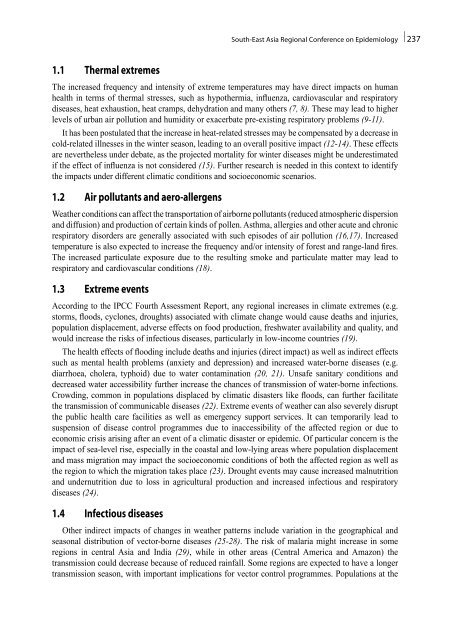South-East Asia Regional Conference on Epidemiology
South-East Asia Regional Conference on Epidemiology
South-East Asia Regional Conference on Epidemiology
You also want an ePaper? Increase the reach of your titles
YUMPU automatically turns print PDFs into web optimized ePapers that Google loves.
1.1 Thermal extremes<br />
<str<strong>on</strong>g>South</str<strong>on</strong>g>-<str<strong>on</strong>g>East</str<strong>on</strong>g> <str<strong>on</strong>g>Asia</str<strong>on</strong>g> <str<strong>on</strong>g>Regi<strong>on</strong>al</str<strong>on</strong>g> <str<strong>on</strong>g>C<strong>on</strong>ference</str<strong>on</strong>g> <strong>on</strong> <strong>Epidemiology</strong> | 237<br />
The increased frequency and intensity of extreme temperatures may have direct impacts <strong>on</strong> human<br />
health in terms of thermal stresses, such as hypothermia, influenza, cardiovascular and respiratory<br />
diseases, heat exhausti<strong>on</strong>, heat cramps, dehydrati<strong>on</strong> and many others (7, 8). These may lead to higher<br />
levels of urban air polluti<strong>on</strong> and humidity or exacerbate pre-existing respiratory problems (9-11).<br />
It has been postulated that the increase in heat-related stresses may be compensated by a decrease in<br />
cold-related illnesses in the winter seas<strong>on</strong>, leading to an overall positive impact (12-14). These effects<br />
are nevertheless under debate, as the projected mortality for winter diseases might be underestimated<br />
if the effect of influenza is not c<strong>on</strong>sidered (15). Further research is needed in this c<strong>on</strong>text to identify<br />
the impacts under different climatic c<strong>on</strong>diti<strong>on</strong>s and socioec<strong>on</strong>omic scenarios.<br />
1.2 Air pollutants and aero-allergens<br />
Weather c<strong>on</strong>diti<strong>on</strong>s can affect the transportati<strong>on</strong> of airborne pollutants (reduced atmospheric dispersi<strong>on</strong><br />
and diffusi<strong>on</strong>) and producti<strong>on</strong> of certain kinds of pollen. Asthma, allergies and other acute and chr<strong>on</strong>ic<br />
respiratory disorders are generally associated with such episodes of air polluti<strong>on</strong> (16,17). Increased<br />
temperature is also expected to increase the frequency and/or intensity of forest and range-land fires.<br />
The increased particulate exposure due to the resulting smoke and particulate matter may lead to<br />
respiratory and cardiovascular c<strong>on</strong>diti<strong>on</strong>s (18).<br />
1.3 Extreme events<br />
According to the IPCC Fourth Assessment Report, any regi<strong>on</strong>al increases in climate extremes (e.g.<br />
storms, floods, cycl<strong>on</strong>es, droughts) associated with climate change would cause deaths and injuries,<br />
populati<strong>on</strong> displacement, adverse effects <strong>on</strong> food producti<strong>on</strong>, freshwater availability and quality, and<br />
would increase the risks of infectious diseases, particularly in low-income countries (19).<br />
The health effects of flooding include deaths and injuries (direct impact) as well as indirect effects<br />
such as mental health problems (anxiety and depressi<strong>on</strong>) and increased water-borne diseases (e.g.<br />
diarrhoea, cholera, typhoid) due to water c<strong>on</strong>taminati<strong>on</strong> (20, 21). Unsafe sanitary c<strong>on</strong>diti<strong>on</strong>s and<br />
decreased water accessibility further increase the chances of transmissi<strong>on</strong> of water-borne infecti<strong>on</strong>s.<br />
Crowding, comm<strong>on</strong> in populati<strong>on</strong>s displaced by climatic disasters like floods, can further facilitate<br />
the transmissi<strong>on</strong> of communicable diseases (22). Extreme events of weather can also severely disrupt<br />
the public health care facilities as well as emergency support services. It can temporarily lead to<br />
suspensi<strong>on</strong> of disease c<strong>on</strong>trol programmes due to inaccessibility of the affected regi<strong>on</strong> or due to<br />
ec<strong>on</strong>omic crisis arising after an event of a climatic disaster or epidemic. Of particular c<strong>on</strong>cern is the<br />
impact of sea-level rise, especially in the coastal and low-lying areas where populati<strong>on</strong> displacement<br />
and mass migrati<strong>on</strong> may impact the socioec<strong>on</strong>omic c<strong>on</strong>diti<strong>on</strong>s of both the affected regi<strong>on</strong> as well as<br />
the regi<strong>on</strong> to which the migrati<strong>on</strong> takes place (23). Drought events may cause increased malnutriti<strong>on</strong><br />
and undernutriti<strong>on</strong> due to loss in agricultural producti<strong>on</strong> and increased infectious and respiratory<br />
diseases (24).<br />
1.4 Infectious diseases<br />
Other indirect impacts of changes in weather patterns include variati<strong>on</strong> in the geographical and<br />
seas<strong>on</strong>al distributi<strong>on</strong> of vector-borne diseases (25-28). The risk of malaria might increase in some<br />
regi<strong>on</strong>s in central <str<strong>on</strong>g>Asia</str<strong>on</strong>g> and India (29), while in other areas (Central America and Amaz<strong>on</strong>) the<br />
transmissi<strong>on</strong> could decrease because of reduced rainfall. Some regi<strong>on</strong>s are expected to have a l<strong>on</strong>ger<br />
transmissi<strong>on</strong> seas<strong>on</strong>, with important implicati<strong>on</strong>s for vector c<strong>on</strong>trol programmes. Populati<strong>on</strong>s at the









